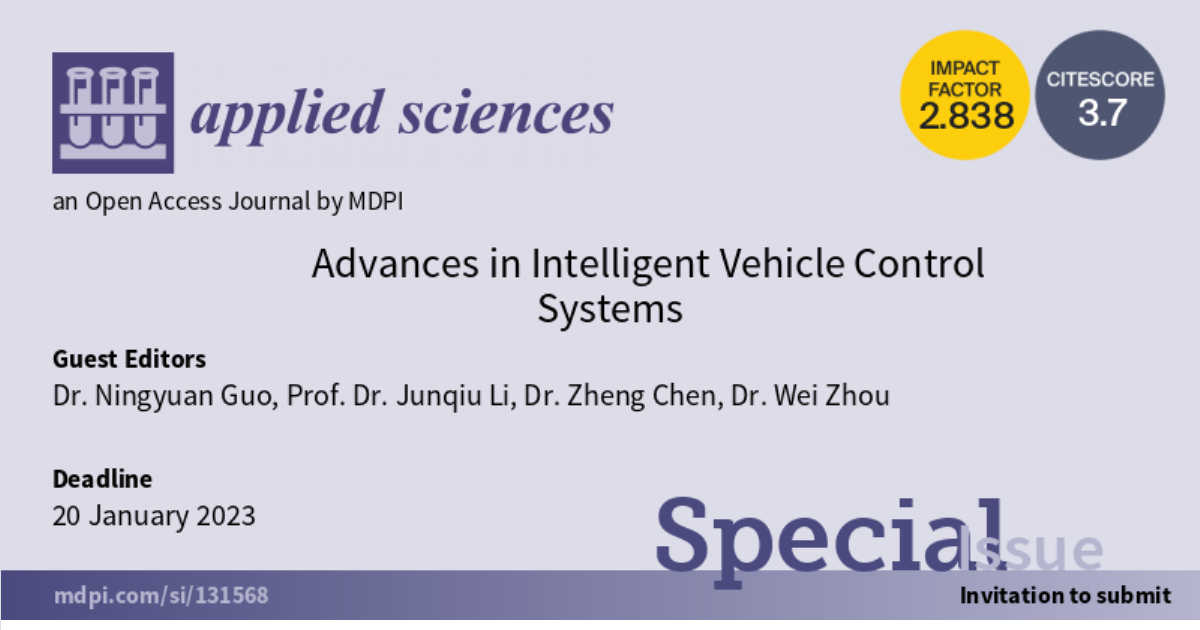Advances in Intelligent Vehicle Control Systems
A special issue of Applied Sciences (ISSN 2076-3417). This special issue belongs to the section "Transportation and Future Mobility".
Deadline for manuscript submissions: closed (20 July 2023) | Viewed by 5322

Special Issue Editors
Interests: vehicle dynamics control; intelligent control of electric vehicles; autonomous vehicles; optimal control
Special Issues, Collections and Topics in MDPI journals
Interests: distributed drive and control; design and management for powertrain systems; thermal and safety management for batteries; intelligent drive of connected vehicles
Interests: optimal control of hybrid electric vehicles; state estimation and management for batteries; optimal control of connected vehicles; motor drive control
Special Issue Information
Dear Colleagues,
The era of intelligent vehicles has come. Superior vehicle intelligence is promising to improve drive safety, road utilization, energy efficiency, and environmental friendliness, leading to significant revolutions in industry and daily life. However, to make these happen, research communities still need to address several challenges. A vehicle system is a multi-component coupling and highly nonlinear device, leading to huge difficulties in improving the effects of modelling, sub-system state estimation, and control. Perception information about surrounding environments, drive conditions, and vehicle states is non-negligible for intelligent vehicles, but many challenges are still to be addressed, especially under off-road driving conditions. The increasing utilization rate of intelligent vehicles, as well as vehicle-to-vehicle/vehicle-to-cloud communication, also raise demands for the development of timely fault diagnosis, effective fault-tolerance schemes, reliable information selection, the framework applicability of strategies, etc.
This Special Issue encourages researchers working in this field to share their latest developments on perception, estimation, decision making, motion planning, control, design, model, simulation, diagnosis and fault-tolerance, and application which are relevant for intelligent vehicle control systems.
The topics of interest include, but are not confined to:
- Perception and estimation technologies: sensor fusion techniques for drive environments, state estimation for intelligent systems (i.e., information for components and vehicular networks), etc.
- Decision making and motion planning: novel motion planning frameworks and technologies, decision making and trajectory planning under challenging environments (e.g., indoor, outdoor, structured, and unstructured etc.).
- Advanced design in powertrain and chassis configuration: novel propulsion architectures and highly efficient sizing methods to enhance energy efficiency, maneuverability, and functionality.
- Control algorithm: advanced control regarding vehicular sub-systems (battery, fuel cell, motor etc.), powertrain, vehicle dynamics, queue, and formation, to improve the effects in energy efficiency, maneuverability, handling stability, trajectory tracking, and their coordination.
- Connectivity exploitation: construction of application scenes, data-driven parameters sizing, vehicular control, and topology development under drive conditions of vehicle-to-vehicle/vehicle-to-cloud communication.
- Modelling and simulation techniques: high-accuracy modelling and accelerated simulation methods for function assessments, including field testing development and those with digital-twin techniques.
- Artificial intelligence techniques: theory and applications using machine learning to address issues in improving training convergence, robustness, stability, and acceptation-oriented standardization etc., for various applications in intelligent vehicle control.
- Diagnosis and fault-tolerance control: diagnosis and fault-tolerance mechanisms/approaches to ensure operations for safety-critical vehicle systems (sub-systems, actuators, sensors etc.)
- Application cases: application illustrations of intelligent vehicle control with favorable reference value, for cars, tracked vehicles, off-road vehicles, e-bikes, buses, heavy-duty vehicles and so forth.
Dr. Ningyuan Guo
Prof. Dr. Junqiu Li
Dr. Zheng Chen
Dr. Wei Zhou
Guest Editors
Manuscript Submission Information
Manuscripts should be submitted online at www.mdpi.com by registering and logging in to this website. Once you are registered, click here to go to the submission form. Manuscripts can be submitted until the deadline. All submissions that pass pre-check are peer-reviewed. Accepted papers will be published continuously in the journal (as soon as accepted) and will be listed together on the special issue website. Research articles, review articles as well as short communications are invited. For planned papers, a title and short abstract (about 250 words) can be sent to the Editorial Office for assessment.
Submitted manuscripts should not have been published previously, nor be under consideration for publication elsewhere (except conference proceedings papers). All manuscripts are thoroughly refereed through a single-blind peer-review process. A guide for authors and other relevant information for submission of manuscripts is available on the Instructions for Authors page. Applied Sciences is an international peer-reviewed open access semimonthly journal published by MDPI.
Please visit the Instructions for Authors page before submitting a manuscript. The Article Processing Charge (APC) for publication in this open access journal is 2400 CHF (Swiss Francs). Submitted papers should be well formatted and use good English. Authors may use MDPI's English editing service prior to publication or during author revisions.
Keywords
- perception and estimation technologies
- decision making and motion planning
- advanced design in powertrain and chassis configuration
- control algorithms
- connectivity exploitation
- modelling and simulation techniques
- artificial intelligence techniques
- diagnosis and fault-tolerant control
- application cases
Benefits of Publishing in a Special Issue
- Ease of navigation: Grouping papers by topic helps scholars navigate broad scope journals more efficiently.
- Greater discoverability: Special Issues support the reach and impact of scientific research. Articles in Special Issues are more discoverable and cited more frequently.
- Expansion of research network: Special Issues facilitate connections among authors, fostering scientific collaborations.
- External promotion: Articles in Special Issues are often promoted through the journal's social media, increasing their visibility.
- Reprint: MDPI Books provides the opportunity to republish successful Special Issues in book format, both online and in print.
Further information on MDPI's Special Issue policies can be found here.








